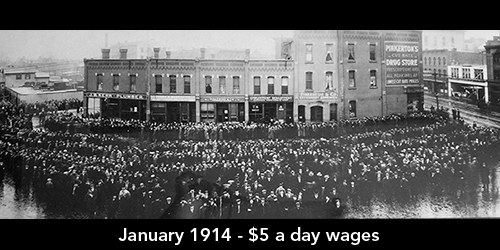 Henry Ford came up with the number one management idea of the 20th Century: pay the employees what they are worth. On January 5, 1914, Henry Ford doubled his workers wages to $5 a day, which brings us back to the early days of ASE’s history as the labor exchange providing workers to Ford Motor Company. By increasing the wages, it paid not only for the way the work was being done, but also valued the time the worker spent in a monotonous setting. It also gave the workers enough extra money to buy one of the cars they were producing.
Henry Ford came up with the number one management idea of the 20th Century: pay the employees what they are worth. On January 5, 1914, Henry Ford doubled his workers wages to $5 a day, which brings us back to the early days of ASE’s history as the labor exchange providing workers to Ford Motor Company. By increasing the wages, it paid not only for the way the work was being done, but also valued the time the worker spent in a monotonous setting. It also gave the workers enough extra money to buy one of the cars they were producing.
In recent years, the question of the $7.25 per hour minimum wage and the effects of raising it has been hotly debated on both sides of the political coin. Can you believe that in 1938 when minimum wage was first enacted, it was 25 cents an hour? Our current minimum wage was last updated 12 years ago in 2009. Since then, a variety of jurisdictions from states to local government recognized the issue of a living working wage and increased their minimum wages either outright or gradually to $15 per hour.
After the great recession, wage growth stalled. Wages in relative terms were about the same as in the 1970s or so. Benefit costs, specifically healthcare costs, became the focus of increases, especially as healthcare costs increased by more than double digits year in and year out. While wages were stagnant (anywhere up to 3% per year growth), compensation packages continually increased towards double digits.
The argument for increasing salaries comes in two parts:
1. An attraction and retention tool for employees (satisfying their belief that they are paid for what they consider they are worth.)
2. Providing a living wage. $7.25 an hour does not cut it and keeps people at poverty level, with greater reliance on government aide. The argument against it is that as labor costs are the major cost component of a business, the price of goods cannot be raised that high or the business will fail. By raising the lower level, all levels have to be adjusted going back to the argument that the price of goods cannot be raised the same as the salary level increase.
Businesses are finding that increasing wages actually increases productivity which in turn has increased margins and sales. One business owner, Charlie Braun, was debating the question of increasing salaries and its impact on his company, a rubber parts factory.
Mr. Braun decided to raise salaries for some employees three times this year. Starting pay for machine operators, the toughest position to fill, jumped by $4.55 to $18.25 an hour, and to $19 for the night shift.
The higher wages not only increased headcount to 124 in July from 91 at the end of January, but also profit margins ranged from between 5% and 6%, roughly double the 3% the company had come to expect in a good year.
According to Mr. Braun, labor costs, including taxes and benefits, now account for about 17% of sales, up from 12% eight years ago, yet the extra labor has helped the company to fill more orders, and sales rose nearly 50% in the first seven months of 2021 versus a year earlier. That allowed better use of equipment and other fixed assets—to a degree that surprised Mr. Braun.
The higher margins are good for him, and employees also benefit through the company’s profit-sharing plan. Eligible employees received $355 in the second quarter of this year, the most the company has paid since 2012.
What is the moral of the story? Employers need to recalculate the value of their employees and line up salaries to those values. A telling sign is high turnover or high job openings unable to fill. It is likely Mr. Braun’s situation will be more common than the exception.
Additional ASE Resources
Compensation Consulting - ASE can also help you evaluate your current compensation to ensure you are paying competitively. For more information, contact Kevin Marrs.
Source: The Henry Ford, Wall Street Journal 8/6/21